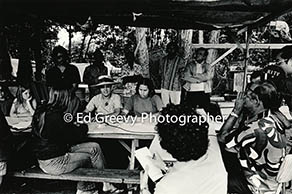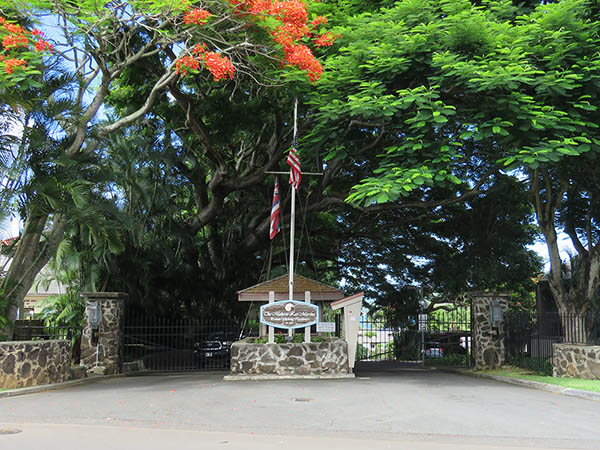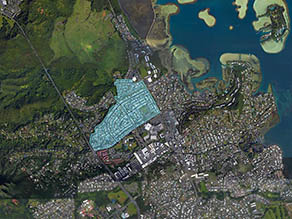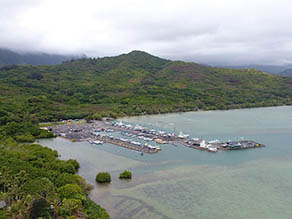 |
 |
 |
 |
||||||
|
|
|
|
|
|
|
|
|
|
| People | Environment | Losing Land | Development | Sovereignty | Language | Sources & Links | |||||||||
 |
“You know Crown Terrace?” Rocky asks. “It’s right behind the church, all that subdivision over there. They could not build that subdivision until my family signed a piece of paper. I remember my family fighting for weeks over it, my uncles, because they wanted to shut the ‘auwai. The ‘auwai is the water system. One uncle did not want to sign it. One of my uncles who worked for a trust company, said ‘You'd be foolish not to sign. They’re going to give us X amount of money. They’re going to help us do our sewage.’ My other uncle said, ‘Once you sign off the water rights, we’ll never get it back.’ “There’s weeks of fighting over that. They’re finding the money guys going out because the other guys were saying, ‘They want to fix your houses and they can’t hook up the sewage because everybody has cesspools. "But to build a subdivision, they put the sewage system in. That is how they got the subdivision. It was not for a family signing off in the ‘auwai, because the ‘auwai system went right through our properties. We’ve always had kuleana from birth. It goes back generations over 200 years, and it ran all the way out into the ocean. That’s the sad part, that they signed it off. “Kamehameha Schools had a lot to do with it. They are guilty of that. They evicted the entire community of He‘eia Kea, over 200 families. They evicted them all out of there before we could finally stop them, just a few of us. I’m the last one back there. The whole valley had to move. The saddest part is there was all majority Hawaiian farmers. I had to watch them all pack up and leave for nothing. 
“Across the pier, that valley there had over 200 families, it was all farmers. They were going to build a nuclear power plant because they said the bowl shape, it would pollution free, it would not harm the environment, but they needed the ocean water for cooling. Oh, but that helped us too because that ocean water was also zone AA waters. “We went up all up to the Supreme Court, and we had outside people who did a big help. They actually taught me how to be a communications person really well. They wanted us to have signs and yell ‘People United Will never be defeated!’ And I said, ‘I will not do that.’ Our strategy was, everybody wear a lei—a plumeria lei, or a puakenikeni, or pikake or pakalana. Everybody was to wear a smelling lei. Everybody wore a lei. “We went to the Supreme Court. There were five judges. It was storming so bad, the thunder and lightning. All of a sudden, the electric went out and the whole place came dark. But they called the recess and went in the back. You know what? It was the right thing. Our attorney, haole girl, Kathleen Deshiota, I loved her. She had on these pikakes, these pakalanas, and she was also happy. You can smell the flowers. It was like spiritual. It’s like all of our kūpuna was in that courtroom, it was so strong. In about half an hour, they came back. Case dismissed. They threw it out of court. We won it. It was like a blessing. Of course, we went bankrupt. “I never liked Bishop Estate—now they changed the name to Kamehameha Schools because bad taste, ‘Bishop Estate.’ Bishop Estate had the habit of leasing out their properties to our native Hawaiians, and they had the habit of evicting them any time they wanted to. Their excuse was it was their kuleana to make money for the schools. And our people, a lot of them didn’t own the land but were always brought up to mālama the land, you took care of it. After the farmers worked so hard to mālama, and put it into farms, and then to get evicted for supposedly better development, expensive homes, that is a part I never did like about Bishop Estate until today.”
|
 |
|||||||
 |
The loss of land leads directly to attempst to mitigate against the forces of development that threaten the environment and landscapes of He‘eia.
|
 |
||
 |
|
 |
||

|
 |
||||
|
||||
Copyright 2019 Pacific Worlds & Associates • Usage Policy • Webmaster |
||||



